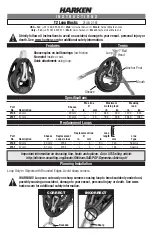
Important Safety Information
•
69
Important Safety Information
DISCLAIMER
THIS EQUIPMENT IS NOT INTENDED TO BE USED AND SHOULD
NOT BE USED IN HUMAN EXPERIMENTATION OR APPLIED TO
HUMANS IN ANY WAY. THIS UNIT GENERATES HIGH VOLTAGE
AND CARE SHOULD BE TAKEN IN ITS OPERATION IN ANY
ENVIRONMENT.
WARNINGS MAIN UNIT AND HEADSTAGE
NO CUSTOMER SERVICEABLE COMPONENTS ARE CONTAINED
WITHIN THIS UNIT. CONSULT THE MANUFACTURER FOR
REPAIR/RETURN INSTRUCTIONS.
IF THE EQUIPMENT IS USED IN ANY MANNER NOT SPECIFIED BY
THE MANUFACTURER, THE PROTECTION PROVIDED BY THE
EQUIPMENT MAY BE IMPAIRED.
HAZARDOUS VOLTAGE MAIN UNIT
To prevent electric shock and damage to the instrument, do not
attempt to open unit.
HAZARDOUS VOLTAGE HEADSTAGE
To prevent electric shock and damage to the instrument, do not
attempt to open unit. The voltage and current present at the
headstage Output connector and brass case connector may
produce an electric shock. To avoid receiving an electrical shock
from the headstage, do not make physical contact between the
input for the micropipette holder and the signal ground input of the
headstage when the Axoporator is switched ON. Circuitry
contained within the main unit limits the voltage and current
present at the headstage Output connector to voltages
≤
±
100 V
DC
and currents
≤
2 mA
DC
under normal operation and
≤
±
150 V
DC
and
≤
15 mA
DC
under single fault conditions. This device complies with
IEC 61010: Measurement Category III.
POWER-SUPPLY
Supply Voltage
The power supply of the Axoporator 800A can be directly
connected to all international supply voltages. The input range is
from 100 to 240 V~. No range switching is required.
Resetting Axoporator following power supply shut down
If the power supply shuts down, disconnect the power cord
from the outlet and disconnect the power supply from the
Axoporator.
Investigate the reason for the circuit overload.
If it is deemed safe to do so, reconnect the power cord to the outlet
and the power supply to the Axoporator.
Basic Equipment Setup and Safety
1. Connections: Use the included IEC power cord to connect the
instrument to a GROUNDED power receptacle. That is, the
mains power cord must be plugged into an earthed mains
outlet. Routinely inspect the mains power cord and replace it if
it’s damaged.
2. Assembly: The headstage connects to the instrument through
the rear panel, 15 pin D-sub connector marked "Headstage".
Power should always be turned OFF when the headstages is
connected to or disconnected from the main unit.
3. There are no user serviceable parts. Do not open the case of
the Axoporator, headstage or power supply. Contact the
factory for repairs.
4. Cleaning: Remove the power cord from the unit. Use a soft
cloth moistened with distilled water to clean dust and salt spills
from the Axoporator 800A and AP-1A headstage. Do not use
solvents or detergents. Do not use abrasive material. Avoid
spilling liquids on the Axoportator 800A or AP-1A headstage.
The Teflon input connector should be kept very clean. Effective
cleaning can be done by swabbing carefully with denatured
ethyl or isopropyl alcohol or deionized water. If possible, avoid
the use of Freon since it is thought to be detrimental to the
environment.
Safe Environmental Conditions
1. Indoor use.
2. Mains supply fluctuations: not to exceed ±10% of the nominal
voltage.
3. Temperature: between 5 ºC and 40 ºC.
4. Altitude: up to 2000 m.
5. Humidity: maximum relative humidity 80% for temperatures up
to 31 ºC decreasing linearly to 50% relatitve humidity at 40 ºC.
6. Overvoltage: withstands a transient overvoltage impulse in
accordance with category II of IEC 60363-4-443.
7. Pollution Degree: suitable for use in POLLUTION DEGREE 2
environment.
8. This instrument is designed to be used under laboratory
conditions. Operate in a clean, dry environment only. Do not
operate in a wet or damp environment.
Static Precautions
If you are in a laboratory where static is high (
i.e.,
you hear and feel
crackles when you touch things), you should touch a grounded
metal object immediately before touching the headstage.
Important Safety Information



































